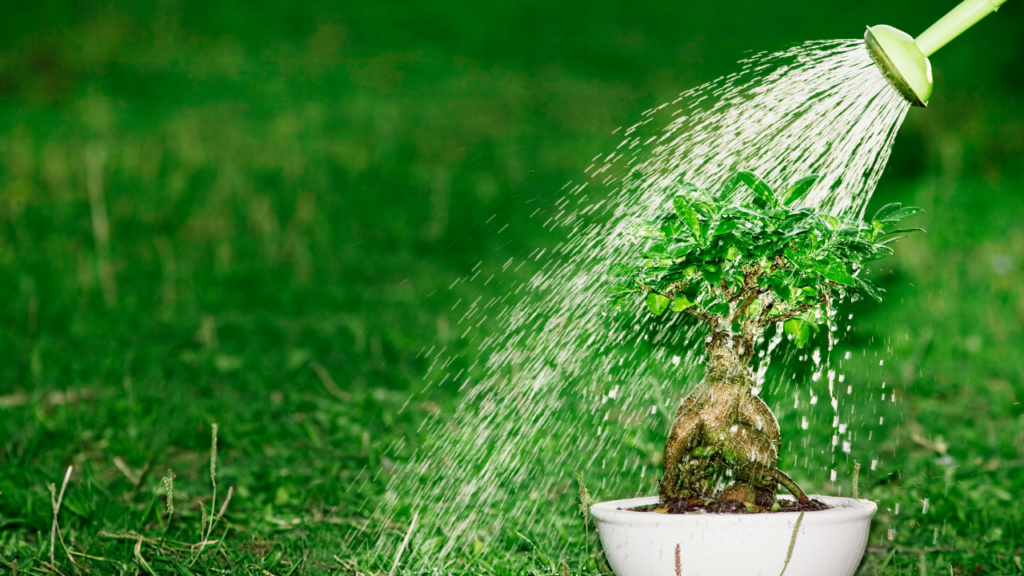Watering is a fundamental aspect of bonsai care. Like all living plants, bonsai trees need water to survive. However, the process of watering bonsai trees is not as straightforward as it might seem. It involves understanding the specific needs of your bonsai tree and adjusting your watering routine accordingly. In this guide, we’ll explore the art of watering bonsai trees, discussing how much water a bonsai tree needs, how often to water, and how to do it effectively.
Understanding Your Bonsai’s Water Needs
Like mature trees in the wild, bonsai trees pump water from their roots to their foliage. They need enough water to supply all of their leaves and prevent them from drying out. However, bonsai trees are often grown in shallow pots with a smaller amount of soil, which means they can dry out more quickly than trees planted in the ground.
On the other hand, it’s also possible to over-water a bonsai tree. If the roots are constantly soaked, they can rot, damaging and eventually killing the tree. Therefore, it’s crucial to strike a balance – providing enough water but not too much.
Factors Affecting Your Bonsai’s Water Needs
Several factors can affect this balance. These include the location of your bonsai tree, the size of the tree, the windiness of the environment, the type of soil used, how pot-bound the tree is, and the size of the pot.
For instance, if the weather is warmer, the tree will need to pump more water to supply the foliage. In hot weather, you will need to water more. Similarly, if the weather is windy, the tree will lose more water through its leaves, requiring more frequent watering.
The size of the bonsai tree also affects how much water it needs. Smaller bonsai trees are generally grown in smaller pots, which have less soil. The soil holds water, so smaller bonsai trees will need watering more often than bigger bonsai trees.
How to Water Bonsai Trees
When watering your bonsai tree, it’s important to soak the soil thoroughly. This ensures that all of the soil gets wet, reaching the roots at the bottom of the pot.
Outdoors, you can use a watering can or hosepipe. Just be careful not to wash all of the soil out of the pot. Indoors, you might want to be more careful to avoid getting water everywhere. One method is to fill a bowl with water and submerge the pot. This ensures that all of the soil gets wet but requires careful handling to avoid washing out any loose soil.
The foliage and branches also benefit from being watered. This washes off dust and helps deter pests.
The Importance of Humidity
Humidity plays a crucial role in the health of your bonsai tree. On hot days and in a paved place surrounded by walls, the trees can suffer from low humidity. You can increase humidity near your Bonsai tree by placing it on a humidity tray filled with water and by misting your tree a few times a day. What also helps is to wet the shelves, floors, and walls around the trees.
Repotting and Watering
Repotting is an essential part of bonsai care. It prevents the tree from being pot-bound and starving to death. After repotting, it’s important to water the tree thoroughly. This will settle the soil and fill up any remaining air pockets. Protect the tree from strong winds and sun for about two months after repotting. Start fertilizing one month after the repotting.
Conclusion
Watering is a crucial aspect of bonsai care, requiring a deep understanding of your tree’s specific needs and a careful balance between providing enough water and not over-watering. By understanding the factors that affect your bonsai’s water needs and learning how to water effectively, you can ensure your bonsai tree thrives and continues to captivate with its unique charm.
Bonsai Watering FAQ
How often should I water my bonsai tree?
The frequency of watering can vary depending on several factors such as the size of the tree, the size of the pot, the type of soil, the weather, and the time of year. As a general rule, water your bonsai tree when the top soil becomes slightly dry.
What is the correct way to water a bonsai tree?
When watering your bonsai tree, it’s important to soak the soil thoroughly. This ensures that all of the soil gets wet, reaching the roots at the bottom of the pot. The foliage and branches also benefit from being watered as it washes off dust and helps deter pests.
Can you overwater a bonsai tree?
Yes, overwatering is a common mistake in bonsai care. If the roots are constantly soaked, they can rot, damaging and eventually killing the tree. It’s crucial to strike a balance – providing enough water but not too much.
What is the role of humidity in bonsai care?
Humidity plays a crucial role in the health of your bonsai tree. On hot days and in a paved place surrounded by walls, the trees can suffer from low humidity. You can increase humidity near your Bonsai tree by placing it on a humidity tray filled with water and by misting your tree a few times a day.
